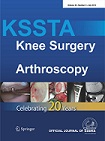
Arthroplasty
Combination of ropivacaine, morphine, and ketorolac may be effective for post-TKA pain
Knee Surg Sports Traumatol Arthrosc. 2015 Mar;23(3):838-45.270 patients scheduled for total knee arthroplasty were randomized to a control group or one of six drug combination groups. The purpose of this study was to assess the analgesic and clinical effects of various periarticular drug combinations in order to determine optimal drug combinations. Pain, opioid consumption, C-reactive protein level, range of motion, and incidence of complications were measured. Results indicated that patients who had received ropivacaine, morphine, and ketorolac, with or without methylprednisolone, in addition to epinephrine, cefazolin, and saline experienced significantly greater pain relief over the first 12 postoperative hours. The addition of methylprednisolone was also associated with significantly greater range of motion, as well as significantly lower levels of C-reactive proteins, though did not significantly impact pain relief as compared to injections without methylprednisolone.
Unlock the full article
Get unlimited access to OrthoEvidence with a free trial
Start TrialCritical appraisals of the latest, high-impact randomized controlled trials and systematic reviews in orthopaedics
Access to OrthoEvidence podcast content, including collaborations with the Journal of Bone and Joint Surgery, interviews with internationally recognized surgeons, and roundtable discussions on orthopaedic news and topics
Subscription to The Pulse, a twice-weekly evidence-based newsletter designed to help you make better clinical decisions
Exclusive access to original content articles, including in-house systematic reviews, and articles on health research methods and hot orthopaedic topics
Or continue reading this full article
Register Now

Subscribe to "The Pulse"
Evidence-Based Orthopaedics direct to your inbox.




































